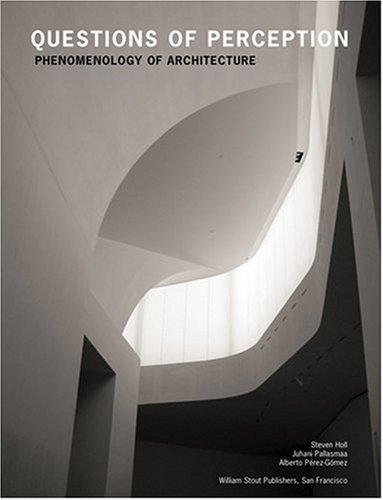Questions of Perception: Phenomenology of Architecture pdf free
Par parker rodger le jeudi, mars 16 2017, 16:11 - Lien permanent
Questions of Perception: Phenomenology of Architecture. Steven Holl, Juhani Pallasmaa, Alberto Perez-Gomez

Questions.of.Perception.Phenomenology.of.Architecture.pdf
ISBN: 0974621471,9780974621470 | 155 pages | 4 Mb

Questions of Perception: Phenomenology of Architecture Steven Holl, Juhani Pallasmaa, Alberto Perez-Gomez
Publisher: William Stout
I believe I am already developing my own 'vision' of what I believe is architecture, but I still want to look more. This summer, I really want to discover my place within the realms of architecture theory. 'questions of space' - by bernard tschumi. If architects move away from the fetishism of . Publication, but by far the most lucid and cogent of his writings. (2006), Exhibition Design, Laurence King, London; Gastil, W., Ryan, Z. 'As a work of art or design that is created by an artist specifically to be sited in a public space,' (The Newport News Public Art Foundation) monuments, memorials and architectural ornamentation are all valid examples. The production of space is marked with its own phenomenology. And theories of spatium, locus, platea and phenomenology. Architects and students who are bored to death by OMA, MVRDV, Hadid, and the rest of the New Postmodernists will find consolation — and inspiration — in this book. Among other things, he produced an influential series of publications called Pamphlet Architecture and coauthored the 1994 book Questions of Perception: Phenomenology of Architecture (now in its third printing). (2004), Open: New Designs for Public Space, Princeton Architectural Press; Holl, S. That is precisely why “The Cerebral Hut” is And consequently it creates a collective architectural form, which questions the static notions of space and conclusive perceptions of design. I'm willing to bet maybe 3 people on archinect actually have this little book - came and went quick in the mid 90's. How Phenomenology into contact with the architecture? In 1941, architectural historian Sigfried Giedion discussed evolving notions of space in his seminal book Space, Time and Architecture. Le sue lezioni sono riunite nel volume “Architecture Spoken”, (Rizzoli New York, 2007). These two intertwined concepts raise questions of identity, perception and materiality. Husserl, its fountainhead, perceived phenomenology as a dualism between mind and body, with mind playing a dominant role because of its implied equivalence to knowledge. Purpose of writing this article attempts to explore the following questions: What is a philosophy of phenomenology thought? In this context, phenomenology of architecture must deliberately evoke a sense of awareness with how humans experience a building and gain a sense of belonging and meaning in the world. It is design-space that temporally re-calibrates its relationship with the outside world, repeatedly and through time, either by actively transforming its physical and conceptual boundaries, or through translating its phenomenological perception by the user. We want to begin by clarifying the terms “space” and “place”. Notions and constructs of space and place define the environment we live in.